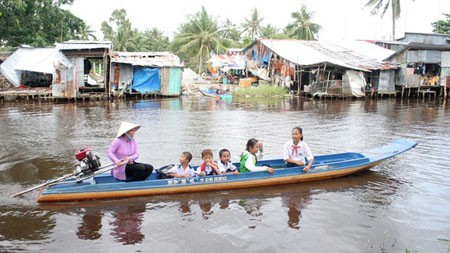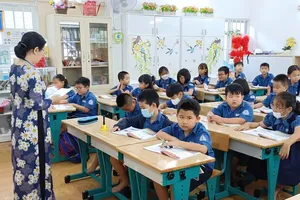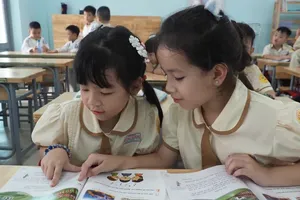
Having a population of nearly 18 million people and contributing around 27 percent to the national GDP annually with a foreign currency income of US$3 billion, the Mekong Delta region should have received corresponding educational investment to regenerate the labor force. Yet statistics show that compared to the average national spending from the state budget for a kindergarten or high school student, at over VND8.372 million per year (approx. $362), the one in the Mekong Delta is merely around VND7.38 million a year ($319). This is the lowest in the whole nation.
The Vietnam State Treasury reported that in the period from 2011 - 2016, local state expenditure including the subsidy of the central government on kindergarten and school education in Vietnam was around VND155,000 billion ($6.7 billion) per year, VND24,603 billion ($1.06 billion) of which was the expense in the Mekong Delta. Accounting for 17.5 percent of the total quantity of school students, this region only received 15.9 percent of the total national spending.
Along with such a low educational investment of the central government via various programs and projects, each local area does not make the situation any brighter due to its budget limit. This has created a grim picture of low-quality education throughout the region.
To make matter worse, teacher distribution in the whole region is facing a severe unbalance. Statistics about the educational human resources allocation in the academic year of 2018-2019 displays that the Mekong Delta needs 11,637 kindergarten teachers, 2,583 primary school teachers, 2,157 secondary school teachers, and 401 high school teachers in certain areas; yet there were about 6,338 unneeded teachers in other areas of the region.
In particular, Kien Giang Province, where the shortage of teachers is the most serious, last year needed more than 600 teachers. But according to Deputy Director of its Department of Education and Training Ninh Thanh Vien, the department could not employ enough staff because of low salary and working conditions in remote districts. Even in the city under the central government of Can Tho, there was still a lack of 396 classrooms and 218 teachers.
The percentage of kindergarten enrollment to school in the Mekong Delta is only about 53.2 percent of the whole nation while the primary school drop-out proportion reaches 55.1 percent. Just 97.5 percent of primary school students continue to the next level, lower than the national average by 1.5 percent. No province in this region achieves the goal of Universalization of Primary Education to level 3.
The region is also facing a severe shortage of classrooms with the lowest ratio of solid classrooms in Vietnam. Some provinces with a low percentage of students learning two sessions per day are Ca Mau (48.7 percent), Tra Vinh (48.3 percent), or An Giang (48.3 percent).
It is now necessary to build 2,400 new classrooms and renovate 2,100 current downgraded ones for the kindergarten level. The primary level needs 900 and 4,200 new and renovated classrooms respectively. The quantity of renovated classrooms for secondary and high levels should be around 2,080.
One of the serious issues in the region is due to the natural terrain with lots of rivers, traveling to and fro school is not truly convenient for children, leading to an abundant number of branches each school has (at nearly 6,000 branches totally), leading to a management difficulty.
According to statistics from the Ministry of Education and Training, in the Mekong Delta, there are 2,029 kindergartens, 1,816 of which are state ones. The total number of primary schools is 3,101, 2,947 of which are state ones.
The percentages of schools that meet the national standards in the region until 2019 are 35.2 percent, 41.3 percent, 40.2 percent, and 26.3 percent in the kindergarten, primary, secondary, and high levels respectively. All are at least 5 percent lower the national proportions.
Therefore, it is high time that the government tackle the problem of outdated and downgraded educational infrastructure and insufficient human resources in the Mekong Delta in order to increase the educational quality of the region.
























